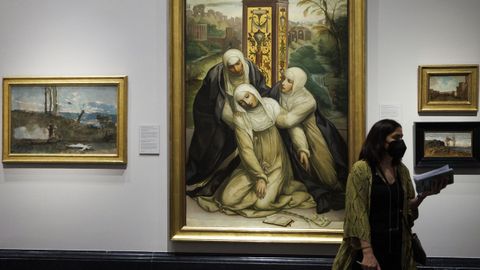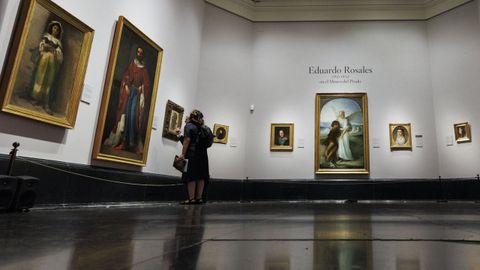
Visitor, before several works by Eduardo Rosales. Author: Sergio Perez | eff
The Museo del Prado pays tribute to the painter on the 150th anniversary of his death by exhibiting seventeen works, some recently acquired
He lived only 36 years, but it was long enough to become one of the “most innovative and influential” authors of the third quarter of the 19th century. Now, on the 150th anniversary of his death, the Museo del Prado is honoring Eduardo Rosales with an exhibition of 17 works, four of which have been recently included and others not on the usual exhibition tour. There are three works that catch the visitor’s eye as soon as they enter room 60 of the Villanueva building. Clothing, almost alive, from Don García Aznar, Count of Aragon (1857), which contrasts with the unfinished appearance and Nazarene aesthetics Tobias and the angel (1858-63), who conducts a dialogue with exuding sadness Stigmatization of Saint Catherine of Siena, from Il Sodoma (1862). The whole set allows us to understand the creative personality of the artist, his evolution and his performance in different genres.
Because, as Andrés Úbeda, deputy director of research and conservation at the art gallery, explains, Rosales was a “multifaceted” painter, capable of dazzling in any genre: from historical painting, its most important aspect, to that of a literary nature – here it is Ophelia (1871), a barely sketched canvas representing the discovery of a corpse floating in a river and showing his appreciation for Shakespeare’s drama—, passing through religious painting, landscape painting, or his “magnificent” work as a portraitist.
One can think of Rosales’ initial interest in Renaissance masters, which he studied during his stay in Italy, or studies related to historical paintings. Mote Castle or Constantine’s room in the Vatican, which makes an increasing simplification. In this sense, and beyond the portraits he created for court families after his success Izabela the Catholic dictates her willwhich brought him the first gold medal for foreigners at the Paris Exhibition in 1867, the ones that he dedicated to his family members stand out, such as the two that inspired his cousin Maximina Martinez de Pedrosa and her maternal aunt Antonio Martínez de Pedrosa — a preliminary sketch representing her dressed in mourning and whose final work has not been found.
Eight restored canvases
In addition to the sample, new restorations were also presented. Of the fourteen exhibited canvases, eight were restored in the last two years by the Prado workshop, and a good number of the others in previous years.
Javier Barón, curator of the exhibition who, in his opinion, along with Marian Fortuny, is “the most innovative painter of the 1860s and 1870s”, thanked Eva Perales, responsible for the restoration of many of these works which, after 41 years of work, were brought to the museum “with with exemplary dedication and maximum quality”, is about to retire.
The exhibition, which can be viewed until January 29, 2024, is complemented by paintings that are part of the permanent exhibition in room 61 B, in which Rosales plays, and in room 101, dedicated to the history of the museum, where it is exhibited Prado Hall and San Jerónima Churchuntil the presentation of a total of 26 pictures.

Detail of the exhibition “Eduardo Rosales (1836-1873) at the Museo del Prado”. Author: Sergio Perez | eff
“The Rosales collection that the Prado has is the largest and best collection in the world – says Barón – and not only in terms of pictures, because it also has more than a hundred drawings”. Barón assures that the prestige that Rosales lived in his time is shown, for example, by the fact that he was the model of the reclining Christ for coming down from the cross Domingo Valdiviesa and his influence is noticeable, he points out, “in the middle of room 75 Prada, with artists after Rosales”.
According to the museum, Carmen Sánchez’s bequest enabled the acquisition and return of two historic paintings whose whereabouts were unknown for a long time: Doña Blanca de Navarra handed over Bucha to the capital and Queen Juana on the ramparts of La Mota Castleas well as an even lesser known study of Constantine’s room in the Vaticanpreparation for Presentation of John of Austria to Emperor Charles V in Yuste. He was also able to purchase a sketch of his last major historical painting, Lucretia’s death. Finally, Landscape and portrait of María Isabel Manuel de Villena, ninth Countess of Granja de Rocamora are shown for the first time.
Source: La Vozde Galicia
I am David Miller, a highly experienced news reporter and author for 24 Instant News. I specialize in opinion pieces and have written extensively on current events, politics, social issues, and more. My writing has been featured in major publications such as The New York Times, The Guardian, and BBC News. I strive to be fair-minded while also producing thought-provoking content that encourages readers to engage with the topics I discuss.







